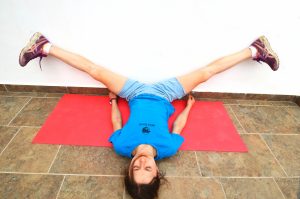The aim of the following text is to give you a short overview over the most common stretching methods. However, due to the multiple stretching methods that can be found in literature as well as in sports, it is almost impossible to give a complete description. Therefore the focus is directed on the so called “moduls” (Klee & Wiemann, n.d.) of each stretching method, which can be combined modularly in order to achieve specific effects.
 Stretching methods – Overview
Stretching methods – Overview
- static
- active
- passive
- PNF
- dynamic
- active
- passive
Static stretching
Static stretching is characterized by moving a limb to the end of its range of motion (ROM) and holding the final position for 15 – 60s (Behm & Chaouachi, 2011).
This can be performed in an active or passive manner or using the PNF-method:
- active: stretching the agonist due to a contraction of the antagonistic muscle
- passive: stretching the agonist using external forces such as performed by a partner or gravity
- PNF (Proprioceptive neuromuscular facilitation)is trying to make use of neuromuscular reflex mechanism resulting in an static stretching of the agonist and can be performed as:
- Antagonist-Contract Stretching (AC): Stretching of the agonist shall be improved by a simultaneous maximum contraction of the antagonist making use of reciprocal inhibition.
- Contract-Release Stretching (CR): At first a maximum isometric contraction of the agonist is performed followed by stretching the same muscle in a static manner. Inbetween a short and relaxing period which doesnt last longer than a few seconds can be performed. The claimed underlying neuromuscular reflex mechanism is called atogenic inhibittion. The maximum contraction inhibits the stretch reflex of the same muscle as the underlying strech and can be better performed.
- Contract-Release Antagonist-Contract Stretching (CR-AC): The combination of the above mentioned methods AC and CR.
However, in the context of PNF no evidence for the mentioned neuromuscular reflex mechanism has been found (Mitchell, Myrer, Hopkins, Hunter, Feland & Hilton, 2009).
Dynamic stretching
Dynamic stretching is characterized by a frequent and fast change between the streched and the relaxed position whereby the movement amplitude is relatively small (Klee & Wiemman, n.d.).
Similar to static stretching, dynamic stretching can as well be performed in an active or passive manner.
The knowledge about the different stretching methods enable us to discuss the different effects of stretching in a more detailed way, which will follow on the next page.
Literature
Behm, D. G., & Chaouachi, A. (2011). A review of the acute effects of static and dynamic stretching on performance. European journal of applied physiology, 111(11), 2633-2651.
Hindle, K. B., Whitcomb, T. J., Briggs, W. O., & Hong, J. (2012). Proprioceptive neuromuscular facilitation (PNF): Its mechanisms and effects on range of motion and muscular function. Journal of human kinetics, 31, 105.
Klee, A. & Wiemann, K. (n.d.). Methoden und Wirkungen des Dehnungstrainings. http://www.biowiss-sport.de/Klee%20Wiemann%20Oostende2.pdf, Acessed 23.08.2017.
Mitchell, U. H., Myrer, J. W., Hopkins, J. T., Hunter, I., Feland, J. B., & Hilton, S. C. (2009). Neurophysiological reflex mechanisms’ lack of contribution to the success of PNF stretches. Journal of sport rehabilitation, 18(3), 343-357.

